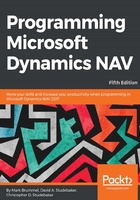
Codeunits
A codeunit is a container for chunks of C/AL code to be called from other objects. These chunks of code are called Functions. Functions can be called from any of the other NAV object types that can contain C/AL code. Codeunits can also be exposed (published) as Web Services. This allows the functions within a published codeunit to be invoked by external routines.
Codeunits are suited structurally to contain only functions. Even though functions could be placed in other object types, the other object types have superstructures that relate to their designed primary use, such as pages, reports, and so on.
Codeunits act only as a container for C/AL coded functions. They have no auxiliary functions, no method of direct user interaction, and no pre-defined processing. Even if we are creating only one or two functions and they are closely related to the primary actpity of a particular object, if these functions are needed from both inside and outside of the report, the best practice is still to locate those functions in a codeunit. For more guidance, see NAV Design Pattern of the Week - the Hooks Pattern at http://blogs.msdn.com/b/nav/archpe/2014/03/16/nav-design-pattern-of-the-week-the-hooks-pattern.aspx.
There are several codeunits delpered as part of the standard NAV product, which are really function libraries. These codeunits consist totally of utility routines, generally organized on some functional basis (for example, associated with Dimensions or some aspect of Manufacturing or some aspect of Warehouse management). Many of these can be found by filtering the Codeunit Names on the Management and Mgt strings (the same could be said for some of the tables with the string Buffer in their name). When we customize a system, we should create our own function library codeunits to consolidate our customizations and make software maintenance easier. Some developers create their own libraries of favorite special functions and include a function library codeunit in systems on which they work.
If a codeunit is structured very simply and can operate in a standalone mode, it is feasible to test it in the same way one would test a report or a page. Highlight the codeunit and click on the Run button. The codeunit will run for a single cycle. However, most codeunits are more complex and must be tested by a calling routine.